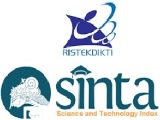FEASIBILITY OF UTILIZATION EAFD AS CEMENT REPLACEMENT IN CONVENTIONAL CONCRETE
Abstract
Abstract — Industrial waste products can be considered as renewable resources, one of them is a steel manufacturing, which produced dust waste contain sponge iron, scrap metal and other steel wastes that impacted to environment. This waste material was called Electric Arc Furnace Dust (EAFD). This study investigates the feasibility of using EAFD as a cement replacement compared to silica fume (SF) and fly ash (FA) in terms of Chemical composition, workability, setting time, compressive strength and rapid chloride permeability resistance. The results showed that workability of EAFD is almost similar to control even if percentage of EAFD was increased. It is not refer to FA more workable or SF less workable with increase percentage of replacement. Furthermore, the EAFD significantly affect the setting time, which 3% EAFD replacement bring to prolong final setting time to more than 24 hours, while the setting time of SF and FA did not significant affected along with the increase replacement percentage. In addition, the 3% EAFD is optimum replacement for compressive strength and it is equivalent replacement level to 5% SF and 15% FA. Finally, the EAFD enhance the resistance for rapid chloride permeability more than FA but less than SF.
Keywords
Full Text:
PDF (Bahasa Indonesia)References
Dustan, E.R., How does pozzolanic reaction make concrete "green"? World of Coal Ash (WOCA), in Denver, CO, USA, 2011.
ACI, Cementitious Materials for Concrete. 2015. E-701.
Zhao, Q., X. Liu, and J. Jiang, Effect of curing temperature on creep behavior of fly ash concrete. Construction and Building Materials, 2015. 96: p. 326-333.
Sanjuán, M.Á., et al., Effect of silica fume fineness on the improvement of Portland cement strength performance. Construction and Building Materials, 2015. 96: p. 55-64.
Tongsheng Zhang, et al., Efficient utilization of cementitious materials to produce sustainable blended cement. Cement & Concrete Composites, 2012. 34: p. 692-699.
Bulut, U., A. Ozverdi, and M. Erdem, Leaching behavior of pollutants in ferrochrome arc furnace dust and its stabilization/solidification using ferrous sulphate and Portland cement. Journal of hazardous materials, 2009. 162(2): p. 893-898.
F.M. Al Mutlaq and C.L. Page, Effects of electric arc furnace dust on susceptibility of steel to corrosion in chloride-contaminated concrete. Construction and Building Materials, 2013. 39: p. 60-64.
de Araújo, J.A. and V. Schalch, Recycling of electric arc furnace (EAF) dust for use in steel making process. Journal of Materials Research and Technology, 2014. 3(3): p. 274-279.
Maslehuddin, M., et al., Effect of electric arc furnace dust on the properties of OPC and blended cement concretes. Construction and Building Materials, 2011. 25(1): p. 308-312.
Thomas, M., The effect of supplementary cementing materials on alkali-silica reaction: A review. Cement and Concrete Research, 2011. 41(12): p. 1224-1231.
ASTM, Standard Specification for Portland Cement. 2015. C150/C150M.
ASTM, Standard Specification for Silica Fume Used in Cementitious Mixtures. 2015. C1240.
ASTM, Standard Specification for Coal Fly Ash and Raw or Calcined Natural Pozzolan for Usein Concrete. 2012. C618.
ASTM, Standard Specification for Flow Table for Use in Tests of Hydraulic Cement. 2013. C230/C230M.
ASTM, Standard Test Method for Electrical Indication of Concrete's Ability to Resist Chloride Ion Penetration. 2012. C1202.
DOI: http://dx.doi.org/10.30811/portal.v9i1.661
Refbacks
- There are currently no refbacks.
Copyright (c) 2018 Amir Fauzi, Syukri Syukri, Mulizar Mulizar, Muhammad Reza






